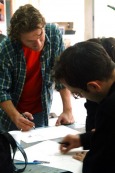
"What advice would you give to a young person who wants a career with a green or sustainability focus?" Recently, I posed that question to wide range of experts in architecture, construction, energy, engineering, finance, government, law and other fields.
The response was so overwhelming that I decided to write a series of blog postings on the subject. In this, the first of the series, we will look at the basic knowledge, skills and experience that a college student or recent grad should develop on the path to building a career with a green and sustainable focus.
What Do You Bring to the Party?
Being "green" and having a passion for sustainability are great starting points. But you must seriously ask yourself what value will you bring to the party. What will you contribute to a team of people trying to help a company, organization, community, or government agency achieve its green and sustainable objectives?
Fortunately, this is a very eclectic party that is open to people with a wide range of talents and levels of experience. The invitations, however, tend to be concentrated around three broad areas of subject matter expertise. You should develop a basic understanding of important concepts in all three, with the objective of becoming an expert eventually in at least one.
1. Science and Technology.
Some of the experts responded to my question with a very hard line. One wrote that you should "get an engineering degree." Another wrote that you should get a degree in either engineering, chemistry or physics. Almost everyone mentioned the need to have some understanding of the principles and science behind sustainability.
I agree that we need more engineers and scientists. If that is your passion, by all means go for it. Almost every solution to help us become more energy efficient, reduce waste, and abate pollution requires the expertise of engineers and scientists. Especially for a younger person, walking into the room with an engineering or science degree will give you an instant level of credibility.
If engineering and the sciences are not your passions, do not worry. There are plenty of other green career options. Still, a basic literacy in science and math is highly recommended even for those who choose other fields. If you want to be an investment banker who decides which green and sustainable technologies will get financed, that's great. Just remember Warren Buffet's advice that he never invests in anything that he doesn't understand. Understanding renewable energy, water conservation, waste management, and just about anything else that might be considered green or sustainable requires a basic understanding of science and math.
The same advice holds true for government officials who make policy, lawyers who advise clients, salespeople who promote products, and anyone else involved in anything green and sustainable. You do not have to become an expert in every scientific field. But you must have sufficient proficiency in science and math to understand what the experts are talking about and to ask intelligent questions.
If you shied away from the sciences in college, do not be intimidated!! I have a little secret for those of you who memorized the second law of thermodynamics to pass high school physics and then quickly put the subject out of your mind. The sciences are a lot easier -- and a lot more fun -- when you re-learn them in real-world applications.
2. Finance and Economics.
Here is where I will introduce you to Howley's First Rule of Sustainability. Repeat after me. Losing money is not sustainable.
The most amazing technology will fail unless you can figure out a way to make it not just affordable but profitable. To do this, you need some basic financial and economic knowledge and skills.
Can you calculate the net present value (NPV) of an investment? How about the internal rate of return (IRR) or the return on investment (ROI)? Do you know what an investment hurdle rate is? These are the basic criteria used by companies when deciding whether or not to make investments. Mediocre technologies get adopted all the time because someone figured out how to make them good financial investments. On the other hand, a brilliant technical presentation on a groundbreaking new technology will be for naught if you look like a deer in the headlights when the CFO starts asking about the NPV, IRR and ROI.
3. Laws, Regulations and Government Policies.
Tristan Knowles, an economist in Australia, responded that when he asked someone for advice on green careers a year ago, they told him to "go to China." In case you haven't heard, China invested $34.6 billion in clean energy last year, compared to $18.6 billion in the US.
China, Brazil, Germany and Spain, among other countries, have promoted growing investments in clean energy by adopting renewable energy and energy efficiency standards, feed-in tariffs, carbon reduction targets and/or caps on carbon emissions. Laws, regulations and government policies have had a similar impact on green and sustainable investments within the US.
Consider, for example, why New Jersey has more solar power installed than almost any other state. It isn't because the mid-Atlantic region is the sunniest part of the country. It is because New Jersey has required that its utilities get at least 22.5% of their electricity from renewable sources by 2021. New Jersey also has one of the best net metering programs in the country and, until recently, it offered a rebate of $3.50 per watt for solar installations over and above the tax credits available from the federal government.
These types of government policies have a tremendous impact on decisions to invest in green and sustainable technologies. Every team needs an expert who understands what these policies are, how they work, who you need to contact at the government agencies, and what changes are in the works. And everyone on the team needs to know enough about government to understand what that person is saying.
Making Your Career Sustainable
Developing basic competencies in these three areas will help you get started and will also do wonders for your career down the line. I can tell you from personal experience that the most fun you will have is when you get together with a group of engineers, scientists, investment bankers, lawyers and other experts and you can actually understand what everyone is saying. You will start to impress people, and you will have a great sense of accomplishment.
Most importantly, developing these basic competencies is essential to building a career that will last a lifetime. No one can predict where the green and sustainable trends will go next. We may get a carbon tax or we may not. We may see a technological breakthrough in hydrogen fuel cells or not. You must develop a foundation of knowledge, skills and experience that will make you valuable no matter what happens next.
Next Steps
There is so much more to share with you from the experts' responses. Where do you go to get the education and training you need? What are your options both inside and outside the classroom? Where can you get entry level experience? What if you are already on a career path and want to change direction? What types of networking are most effective? How do you find a mentor and why is that important? What types of professional certifications are worthwhile pursuing? What types of internships and volunteer opportunities should you consider?
These questions and more will be addressed in future blog postings. To make sure you get them, join our Facebook fan page by clicking here.
John Howley
Orlando, Florida
The response was so overwhelming that I decided to write a series of blog postings on the subject. In this, the first of the series, we will look at the basic knowledge, skills and experience that a college student or recent grad should develop on the path to building a career with a green and sustainable focus.
What Do You Bring to the Party?
Being "green" and having a passion for sustainability are great starting points. But you must seriously ask yourself what value will you bring to the party. What will you contribute to a team of people trying to help a company, organization, community, or government agency achieve its green and sustainable objectives?
Fortunately, this is a very eclectic party that is open to people with a wide range of talents and levels of experience. The invitations, however, tend to be concentrated around three broad areas of subject matter expertise. You should develop a basic understanding of important concepts in all three, with the objective of becoming an expert eventually in at least one.
1. Science and Technology.
Some of the experts responded to my question with a very hard line. One wrote that you should "get an engineering degree." Another wrote that you should get a degree in either engineering, chemistry or physics. Almost everyone mentioned the need to have some understanding of the principles and science behind sustainability.
I agree that we need more engineers and scientists. If that is your passion, by all means go for it. Almost every solution to help us become more energy efficient, reduce waste, and abate pollution requires the expertise of engineers and scientists. Especially for a younger person, walking into the room with an engineering or science degree will give you an instant level of credibility.
If engineering and the sciences are not your passions, do not worry. There are plenty of other green career options. Still, a basic literacy in science and math is highly recommended even for those who choose other fields. If you want to be an investment banker who decides which green and sustainable technologies will get financed, that's great. Just remember Warren Buffet's advice that he never invests in anything that he doesn't understand. Understanding renewable energy, water conservation, waste management, and just about anything else that might be considered green or sustainable requires a basic understanding of science and math.
The same advice holds true for government officials who make policy, lawyers who advise clients, salespeople who promote products, and anyone else involved in anything green and sustainable. You do not have to become an expert in every scientific field. But you must have sufficient proficiency in science and math to understand what the experts are talking about and to ask intelligent questions.
If you shied away from the sciences in college, do not be intimidated!! I have a little secret for those of you who memorized the second law of thermodynamics to pass high school physics and then quickly put the subject out of your mind. The sciences are a lot easier -- and a lot more fun -- when you re-learn them in real-world applications.
2. Finance and Economics.
Here is where I will introduce you to Howley's First Rule of Sustainability. Repeat after me. Losing money is not sustainable.
The most amazing technology will fail unless you can figure out a way to make it not just affordable but profitable. To do this, you need some basic financial and economic knowledge and skills.
Can you calculate the net present value (NPV) of an investment? How about the internal rate of return (IRR) or the return on investment (ROI)? Do you know what an investment hurdle rate is? These are the basic criteria used by companies when deciding whether or not to make investments. Mediocre technologies get adopted all the time because someone figured out how to make them good financial investments. On the other hand, a brilliant technical presentation on a groundbreaking new technology will be for naught if you look like a deer in the headlights when the CFO starts asking about the NPV, IRR and ROI.
3. Laws, Regulations and Government Policies.
Tristan Knowles, an economist in Australia, responded that when he asked someone for advice on green careers a year ago, they told him to "go to China." In case you haven't heard, China invested $34.6 billion in clean energy last year, compared to $18.6 billion in the US.
China, Brazil, Germany and Spain, among other countries, have promoted growing investments in clean energy by adopting renewable energy and energy efficiency standards, feed-in tariffs, carbon reduction targets and/or caps on carbon emissions. Laws, regulations and government policies have had a similar impact on green and sustainable investments within the US.
Consider, for example, why New Jersey has more solar power installed than almost any other state. It isn't because the mid-Atlantic region is the sunniest part of the country. It is because New Jersey has required that its utilities get at least 22.5% of their electricity from renewable sources by 2021. New Jersey also has one of the best net metering programs in the country and, until recently, it offered a rebate of $3.50 per watt for solar installations over and above the tax credits available from the federal government.
These types of government policies have a tremendous impact on decisions to invest in green and sustainable technologies. Every team needs an expert who understands what these policies are, how they work, who you need to contact at the government agencies, and what changes are in the works. And everyone on the team needs to know enough about government to understand what that person is saying.
Making Your Career Sustainable
Developing basic competencies in these three areas will help you get started and will also do wonders for your career down the line. I can tell you from personal experience that the most fun you will have is when you get together with a group of engineers, scientists, investment bankers, lawyers and other experts and you can actually understand what everyone is saying. You will start to impress people, and you will have a great sense of accomplishment.
Most importantly, developing these basic competencies is essential to building a career that will last a lifetime. No one can predict where the green and sustainable trends will go next. We may get a carbon tax or we may not. We may see a technological breakthrough in hydrogen fuel cells or not. You must develop a foundation of knowledge, skills and experience that will make you valuable no matter what happens next.
Next Steps
There is so much more to share with you from the experts' responses. Where do you go to get the education and training you need? What are your options both inside and outside the classroom? Where can you get entry level experience? What if you are already on a career path and want to change direction? What types of networking are most effective? How do you find a mentor and why is that important? What types of professional certifications are worthwhile pursuing? What types of internships and volunteer opportunities should you consider?
These questions and more will be addressed in future blog postings. To make sure you get them, join our Facebook fan page by clicking here.
John Howley
Orlando, Florida


 RSS Feed
RSS Feed